Sights of Yaroslavl
Around Bogoyavlenskaya Ploschad
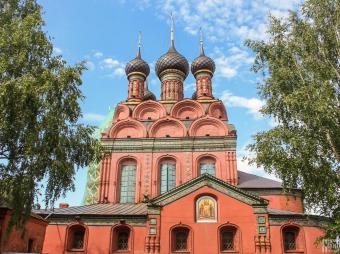
Epiphany Church
- Bogoyavlenskaya Ploschad
The Epiphany Church is another famous example of 17th century Yaroslavl architecture. It was built between 1684 and 1693 on the orders of local merchant Aleksey Zubchaninov. It was the first church in the city to be built without internal pillars. Built out of red bricks, it is topped with five black domes and its exterior is decorated with colourful ceramic tiles and two levels of kokoshniks below the domes. A red-brick bell tower has been built onto one of its corners. Its… Read more »

Prince Yaroslav the Wise Monument
- Bogoyavlenskaya Ploschad
Standing in the very centre of Bogoyavlenskaya Ploschad (Epiphany Square) surrounded by traffic is a statue of the city's founder - the 11th century Prince Yaroslavl the Wise. Yaroslav was Prince of Rostov when he founded Yaroslavl but went on to become Grand Prince of Kiev after he defeated his murderous elder brother Svyatopolk the Accursed. The monument was unveiled in 1993 in the presence of President Boris Yeltsin. Read more »

Spaso-Preobrazhensky Monastery (Yaroslavl Museum-Reserve)
- 25 Bogoyavlenskaya Ploschad
- http://www.yarmp.yar.ru
- May-September: Territory - 08:00 - 20:00. Museums - 10:00 -18:00. October-April: Territory - 08:30 - 18:00. Museums: 10:00 - 17:30. Closed on the first Wednesday of each even month and museums closed on Mondays and other specific days.
It is not known exactly when the Spaso-Preobrazhensky Monastery was founded, but it is believed to date from the early 13th century, having been established by Prince Konstantin of Yaroslavl, shortly before construction work was started on the Transfiguration of the Saviour Cathedral. It was built on the northern bank of the River Kotorosl and served a defensive function as well as a religious one. The princes of Yaroslavl also had a residence at the monastery and were buried in… Read more »
Around the Rubleny Gorod
'Music and Time' Museum
- 33A Volzhskaya Naberezhnaya
- http://xn--80aejfgkmg8ay3g9b.xn--p1ai/
The 'Music and Time' Museum is one of the first privately owned museums in post-Soviet Russia having been opened in 1993 by local collector, actor and magician John Mostoslavky. On display at the museum are musical instruments, gramophones, records, icons, samovars, clocks, irons and bells. Read more »
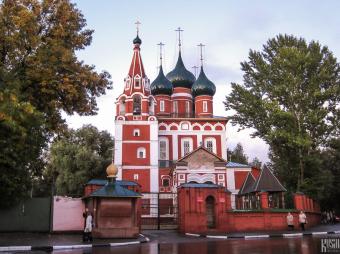
Archangel Michael's Church
- 67 Ulitsa Pervomaiskaya
The current version of Archangel Michael's Church was constructed between 1657 and 1682. Previously a wooden version was constructed by Grand Prince Konstantin of Vladimir and Rostov in 1216 which in turn was replaced on the orders of Princess Anna of Yaroslavl (the Tatar wife of Prince Fyodor the Black) in 1298. The current red church is standard in form: a single building topped with five green domes. Attached to one corner is a tall bell tower. In 1731 the church's interior was… Read more »
Church Ensemble of Annunciation Church and Ascension Church
- 51 Volzhskaya Naberezhnaya
At the top of Volzhskaya Naberezhnaya, just past the River Port, is a church ensemble comprising two churches: the Annunciation Church which is used in summer months and the Ascension Church which is used in winter months. The oldest of the two is the Annunciation Church which dates from between 1688 and 1702. It represents a simplified form of the Yaroslavl-style of church architecture topped with five unusually elongated domes. Inside it was decorated with frescoes between 1708… Read more »
Department of Ancient Russian Culture of the Yaroslavl Museum of Art (Metropolitan’s Chambers)
- 1 Volzhskaya Naberezhnaya
- http://artmuseum.yar.ru
- 10:00 - 18:00. Closed on Mondays and the last Tuesday of the month.
The Metropolitan’s Chambers were built next to the Dormition Cathedral in the 1680s under the building programme of Metropolitan Jonah (Iona) Sysoevich of Yaroslavl and Rostov, who was responsible for constructing many religious buildings throughout the Yaroslavl Region. In 1767 Empress Catherine the Great stayed here during her tour of cities on the Volga. Today the chambers hold the Department of Ancient Russian Culture of the Yaroslavl Museum of Art and display many icons,… Read more »
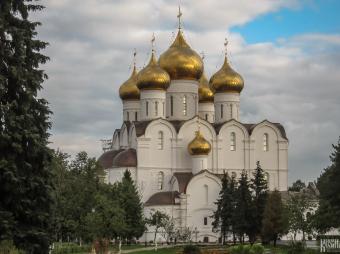
Dormition Eparchial Cathedral
- Ploschad Chelyuskintsev, 2A Kotoroslnaya Naberezhnaya
Construction of the very first stone cathedral dedicated to the Dormition of the Virgin Mary was started in 1215 by Prince Konstantin Vsevolodovich of Yaroslavl on the territory of the Yaroslavl Kremlin on the Strelka. It was consecrated in 1219 and was a cathedral for the Bishop of Rostov and Yaroslavl. The cathedral was later destroyed by fire in 1501 and rebuilt in 1516 to a smaller scale. It was here that Metropolitan Kirill blessed Prince Pozharsky in 1612 as he set off with… Read more »
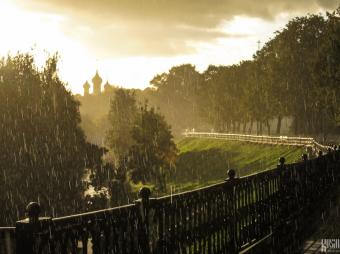
Embankments
- Kotoroslnaya Naberezhnaya and Volzhskaya Naberezhnaya
The embankments along the Kotorosl and the Volga are known as Kotoroslnaya Naberezhnaya and Volzhskaya Naberezhnaya respectively and they meet at confluence of the rivers at the start of Bulvar Mira. They are pleasant just to walk along although several museums and churches are also located here. Also found here are some gazebos which serve as a favourite photo-opportunity for newlyweds. Read more »
History of Yaroslavl Museum
- 17/1 Volzhskaya Naberezhaya
- http://mukmig.yaroslavl.ru/
- 10:00 - 18:00. Closed on Tuesdays.
The History of Yaroslavl Museum was opened in 1999 inside the baroque-style mansion of the Vakhrameev family. Much of the interior of the merchant's mansion has been preserved. The museum's exhibitions tell of the history of the ancient city and display findings from archaeological digs, icons of the princes of Yaroslavl, coins, ancient weapons and many paintings and photographs of famous citizens of Yaroslavl. Read more »
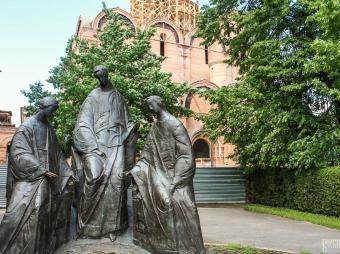
Holy Trinity Sculpture
- Bulvar Mira (in between Kotoroslnaya Naberezhnaya and Volzhskaya Naberezhnaya)
In 1995 in the park where once the altar of the Dormition Cathedral once stood, a sculpture was unveiled dedicated to the Holy Trinity. In its design it is obviously inspired by the famous Trinity Icon by Andrey Rublev for the similarity between the poses of the three angels in the icon and the sculpture. Since the reconstruction of the Dormition Cathedral, the monument is now located just outside the new cathedral. Read more »
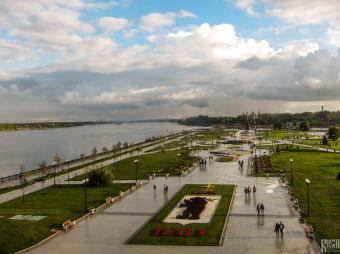
Millennium of Yaroslavl Park
- far end of the Stelka
In the run up to Yaroslavl's 2010 millennium celebrations, a park was created at the end of the Strelka formed where the Kotorosl flows into the Volga. Musical fountains were installed in the park which are especially pretty in the evening when they are lit up. At the very tip of the Strelka the Millennium of Yaroslavl Monument was erected. The monument comprises a statue of Yaroslavl the Wise standing in front of an obelisk. On the four corners of the obelisk's base are four… Read more »
Nativity of Christ Church
- 1 Ulitsa Kedrova
The Nativity of Christ Church was the second church to be built outside of the kremlin and the Spaso-Preobrazhensky Monastery, dating from 1644. Originally a wooden church stood here which in 1609 received a revered copy of the Our Lady of Kazan Icon during the Time of Troubles. The stone church was built using the funds the Guriev-Nazariev family, who were local merchants. In form the church comprises a four-pillar cube building which is surrounded on three sides by a two-storey… Read more »
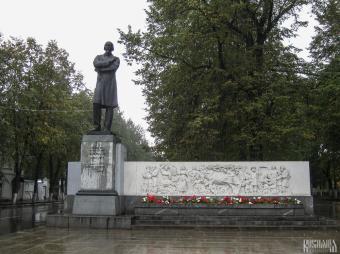
Nikolai Nekrasov Monument
- intersection of Pervomaiskaya Ulitsa and Volzhskaya Naberezhnaya
Nikolai Nekrasov (1821-1877) was a Russian poet who was born in Nemyriv in Ukraine but grew up at his father's estate in Greshnevo near Yaroslavl and later studied in Yaroslavl and bought the Karanika estate near Yaroslavl where he spent many summers. This monument to him includes a statue of him and a large bas-relief depicting characters from his work. Read more »
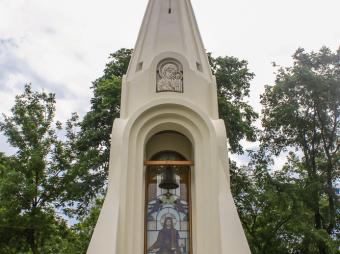
Our Lady of Kazan Chapel
- Kotoroslnaya Naberezhnaya, opposite the Holy Gates of the Spaso-Preobrazhensky Monastery
The Our Lady of Kazan Chapel is both a simple chapel and a rather elegant monument to the People's Army of Minin and Pozharsky who liberated Moscow from the Poles in 1612. It is located opposite the Holy Gates of the Spaso-Preobrazhensky Monastery from where the army set off on its mission. It was opened in 1997 and comprises a tall pyramid with a stained-glass window depicting the Our Lady of Kazan Icon. It has become a symbol of Yaroslavl, partly as it features on one side of the… Read more »
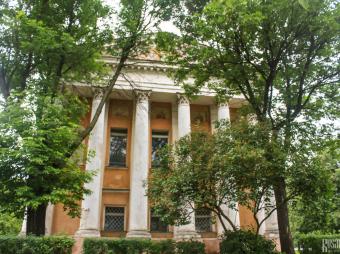
St Elijah the Prophet and St Tikhon's Church
- 5 Volzhskaya Naberezhaya
This church was built on the site of an ancient church dedicated to St Elijah the Prophet, which in turn was said to be built where a pagan temple once stood before Prince Yaroslav the Wise founded Yaroslavl. The current church dates from 1831 and is dedicated to both St Elijah the Prophet and St Tikhon. It is built in the classical style with a single dome and with facades decorated with columns and pediments. Read more »
St Nicholas Nadeina’s Church
- 2 Narodny Pereulok
- http://www.yarmp.yar.ru
- 09:00 – 16:00. Closed on Wednesdays, Thursdays, rainy days and from 1 October to 1 May.
This church was built between 1620 and 1622 making it the oldest church outside of the old kremlin and the Spaso-Preobrazhensky Monastery. It was built using the funds of the merchant Nadey Sveshnikov, hence its name to distinguish it from the other churches in the city dedicated to St Nicholas. In form the church comprises a four-pillar cube building which is surrounded on three sides by a two-storey closed gallery including a tent-dome bell tower on one corner. The interior of… Read more »
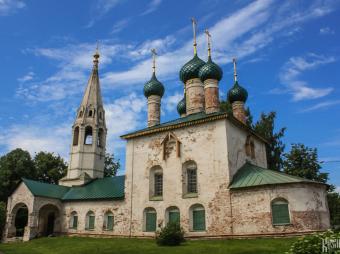
St Nicholas’ Church in Rubleny Gorod
- 8 Kotoroslnaya Naberezhnaya
This church is known as St Nicholas' Church in Rubleny Gorod to differentiate it from other churches dedicated to St Nicholas in the city. It was completed in 1695 and was originally located within the Yaroslav Kremlin. In form the white church has a tall building topped with five green domes and attached via a vestibule to a bell tower. It was closed in 1920 and housed an art gallery before eventually being returned to the church. Read more »
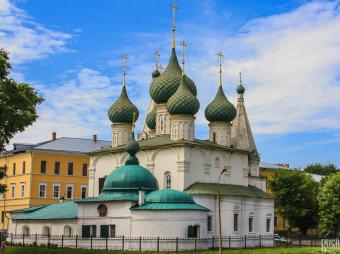
Transfiguration of the Saviour Church in the City
- 3 Kotoroslnaya Naberezhnaya
The Transfiguration of the Saviour Church is often referred to as the Saviour in the City (Spas-na-Gorody) to distinguish it from the Transfiguration of the Saviour Cathedral located in the Spaso-Preobrazhensky Monastery. It was built in 1672 using St John Chrysostom’s Church at Korovniki as a guide. In form it is very similar with a four-tiered building topped with five green domes and with a tower and a bell tower on each side. However, unlike St John Chrysostom’s Church, this… Read more »
Volzhskaya (Arsenalnaya) Tower
- 2A Volzhskaya Naberezhaya
The Volzhskaya Tower is one of the two towers which represent all that is left of Yaroslavl's 17th century fortification walls which once surrounded the whole historical centre. The tower was built between 1658 and 1669 near to the bank of the River Volga after which it is named. However it is also known as the Arsenalnaya Tower as from the mid-19th century the tower was used as an arsenal. Read more »
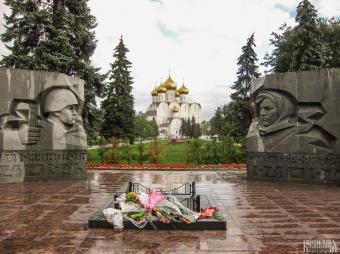
War Memorial and Eternal Flame
- Bulvar Mira (in between Pochtovaya Ulitsa and Volzhsky Spusk)
Yaroslavl's Second World War memorial was opened in 1968 and is made up of two large stone plinths: one with an engraving of a soldier and one with an engraving of a woman, representing the heroes of the front and the heroes of labour respectively. A eternal flame is in between these two plinths which now also perfectly frame the Dormition Cathedral having been rebuilt in its previous location. Read more »
Yaroslavl Museum of Art
- 23 Volzhskaya Naberezhnaya
- http://artmuseum.yar.ru
- 10:00 - 18:00. Closed on Mondays and the last Tuesday of the month. Grounds open from May to October.
The Yaroslavl Museum of Art was founded in 1919 and its main exhibitions are located in an early-19th century house which once served as the residence of the governor. The museum has one of the largest art collections in Russia. As well as holding temporary exhibitions, Russian works of art from the 18th to 20th centuries are permanently on display at the Governor's House. The beautiful grounds are also open to visitors and features several sculptures. The Museum's Department of… Read more »
Around the Zemlyanoy Gorod
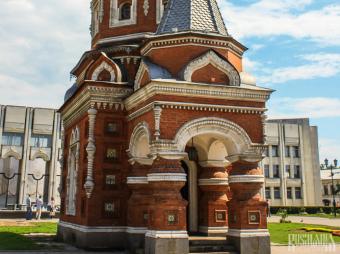
Aleksandr Nevsky’s Chapel
- 8 Ulitsa Andropova
This pretty chapel was built in 1892 and in honour of the miraculous salvation of the tsar and his family when the imperial train crashed near Borki in 1888 . It consists of a small ‘octagon on a cube’ bell tower and a tent-dome covering the entrance, all built in the ancient-Russian style and decorated with elaborate cornices, kokoshniks, and ceramic tiles. Today the chapel serves as a podvorye (embassy church) for the Tolgsky Convent. Read more »
Demidov Column
- Demidovsky Skver, Bulvar Mira
Located in the small park on Demidov Square (Demidovsky Skver) is a column dedicated to Pavel Demidov, who in 1803 founded Yaroslavl's Demidov Academy of Higher Sciences, now known as the Yaroslavl Demidov State University. Originally the column was erected in 1829 but this was taken down for scrap in 1931. It was only replaced in 2005 and is now the tallest monument in Yaroslavl. On top of the column is the Russian double-headed eagle. Read more »
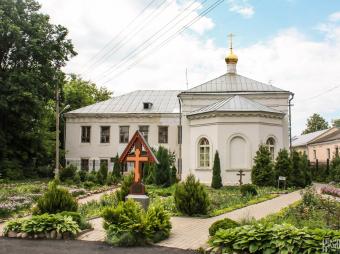
Kazansky Convent
- 20 Ulitsa Trefoleva
The Kazansky Convent was founded in 1610 on the site of a monastery which was destroyed earlier during the Time of Troubles. It was named after its most sacred relic - a 16th century copy of the Our Lady of Kazan Icon. The convent's Our Lady of Kazan Cathedral is the main attraction of the convent and was built between 1835 and 1845 in the classical style. In addition to this there are two other churches: the Intercession Church and the Presentation of the Lord Church, both of… Read more »
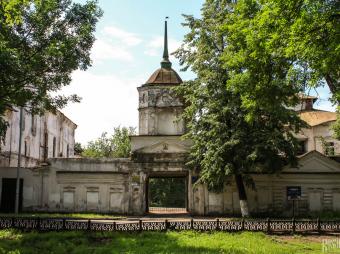
Kirillo-Afanasievsky Monastery
- 17 Ploschad Chelyuskintsev (off Bulvar Mira)
The Kirillo-Afansievsky Monastery was founded in 1616 in commemoration of the city's liberation from the Polish interventionists during the Time of Troubles and shortly afterwards wooden churches were built here to house an icon to which the citizens and the volunteer army prayed. In the second half of the 17th century these wooden churches were rebuilt in stone and the monastery's two churches - the Ss Cyril and Athanasius' Church and the Miracle-Image of the Saviour Church - date… Read more »
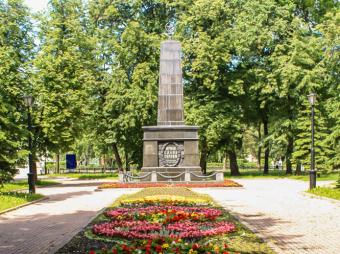
Memorial to the Victims of the 1918 Uprising
- Demidovsky Skver, Bulvar Mira
In 1918 Yaroslavl was the scene of a large uprising against Soviet power which was successful in capturing strategic buildings in the city and arresting Bolsheviks stationed there. The uprising was violently supressed by the Red Army who surrounded the city, cut its supplies and started bombarding it with artillery and air fire, heavily damaging many of the city's landmarks. This small obelisk is dedicated to the 'red' fighters who died supressing the uprising. Read more »
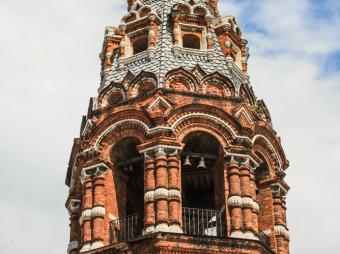
Presentation of the Lord Church
- 4 Deputatsky Pereulok
The Presentation of the Lord Church was built between 1891 and 1895 in the Russian Revival style and is decorated with beautiful patterns made out of brick which were a common feature of ancient Russian churches, especially in Yaroslavl. The church is topped with a tall tent dome. In Soviet time the church was closed and used for production needs but has since been reopened and is used for worship once more. Read more »
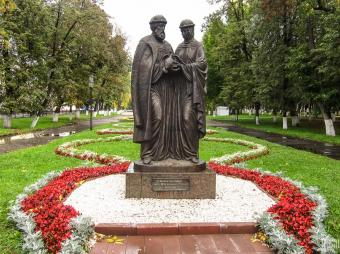
Ss Peter and Fevronia of Murom Monument
- Pervomaisky Bulvar
Ss Peter and Fevronia of Murom are most often identified as Prince Davyd Yurievich of Murom and his wife, who took the names of Peter (Pyotr) and Fevronia upon becoming a monk and nun respectively. Shortly afterwards both died on the same day in 1228. They have since become the Russian patron saints of marriage and family. This monument to them was unveiled in 2009 as part of a nation-wide project to develop the sanctity of marriage and the family in Russia. Read more »
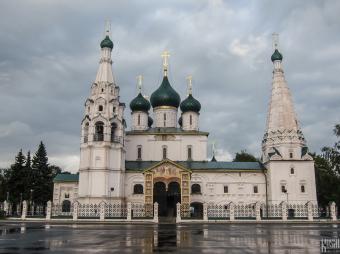
St Elijah the Prophet's Church
- Sovetskaya Ploschad
- http://www.yarmp.yar.ru
- 08:00 – 20:00. Closed on rainy days and from 1 October to 1 May.
According to legend the first church in Yaroslavl was dedicated to St Elijah as it was on this saint's feast day that Yaroslav the Wise killed the bear and conquered the area. This version of the church was built between 1647 and 1650 and is now one of the city's major attractions. It was built in the architectural style typical for Yaroslavl in the 17th century and comprises a white-stone four-pillared main building topped with five green domes connected by a closed gallery to a… Read more »
Ulitsa Kirova Pedestrian Street
- Ulitsa Kirova (and Deputatsky Pereulok)
Ulitsa Kirova runs from Sovetskaya Ploschad (Soviet Square), where the St Elijah the Prophet Church stands, to the Vlasievskaya Tower. Half of this street, along with Deputatsky Pereulok, is a pedestrian zone and the main touristic street in Yaroslavl, with shops, places to eat and several souvenir stalls. Since 1937 it has borne the name of the Soviet Revolutionary Sergey Kirov, but before this it was known as Ulitsa Uglichskaya as it was the start of the road which leads to… Read more »
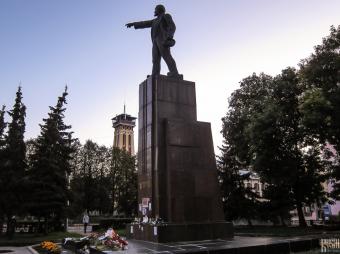
Vladimir Lenin Monument and Watchtower
- Red Square (Krasnaya Ploschad)
Yaroslavl's Lenin Monument depicts the Leader of the October Revolution looking and pointing into the distance. To the left of Lenin is the red and yellow fire station watchtower which was built in the early 19th century. The watchtower was used right up until 1974 and the building is still used as a fire-station. Read more »
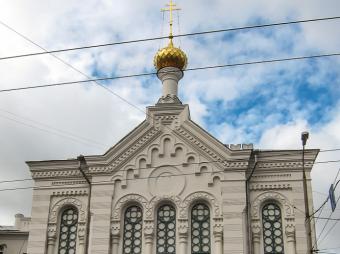
Vlasievskaya (Znamenskaya) Tower and Our Lady of the Sign Chapel
- 2A Pervomaiskaya Ulitsa
Vlasievskaya Tower is one of only two towers which are all that remain of the 16th-century fortified wall which once surrounded the historical centre. It is named after St Blaise (Vlasi in Russian) and was built in stone between 1658 and 1659. It served as one of the five entrances into the fortress. When it was built an icon known as the Our Lady of the Sign Icon (Znamenskaya Ikona) was painted on the wall and at the end of the 19th century a small chapel dedicated to the icon was… Read more »
Away from the Historical Centre

Ensemble of Ascension Church and Presentation of the Lord Church
- 44 Ulitsa Svobody
On Ulitsa Svobody there is a church ensemble comprising two churches: the Ascension Church which is used in summer months and the Presentation of the Lord Church which is used in winter months. The more impressive of the two churches is the Ascension church which was built between 1677 and 1682 and comprises a typical four-tiered white building topped with five green domes. Next to this is the smaller Presentation Church which is slightly younger, dating from 1691, but later… Read more »
Museum of Military Glory
- 44A Ulitsa Uglichskaya
- http://www.yarmp.yar.ru/
- 10:00 - 17:00. Closed on Mondays and Tuesdays.
Yaroslavl's Museum of Military Glory was opened in 1981 on the 40th anniversary of the formation of the Yaroslavl 234th infantry division and is a filial of the Yaroslavl Museum-Reserve. The museum is dedicated to the Soviet Victory during the Second World War and has on display weapons and military equipment as well as information, photographs, medals, uniforms and belongings of Soviet soldiers. Military equipment is on display outside as well as several reliefs of military… Read more »
Our Lady of Vladimir Church
- 44 Ulitsa Rybinskaya
The Our Lady of Vladimir Church is often referred to as the church on the Bozhedomke from the Russian word bozhedom which literally means God's house and was a burial ground for homeless people and people who had drowned. The church was built between 1670 and 1678 and is one of few churches in Russia to have three tent domes in a row. In 1821 the Intercession Church was built next to the Our Lady of Vladimir Church to be used in winter. However much of this was church destroyed in… Read more »
South of the River Kotorosyl
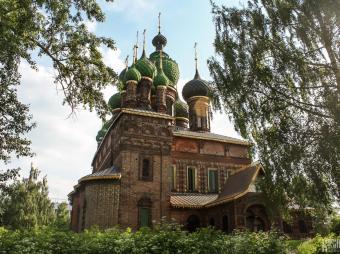
Beheading of St John the Baptist Church at Tolchkov
- 69 2-ya Zakotoroslnaya Naberezhnaya
- http://www.yarmp.yar.ru/
- 10:00 – 17:00. Closed on Mondays, Tuesdays, rainy days and from 1 October to 1 May.
Yaroslavl is so rich in church architecture that is it difficult to rate the various churches, but the Beheading of St John the Baptist Church at Tolchkov would most certainly be near to the top of the list. Only part of its attraction is due to the fact that it appears on the back of the 1000-rouble note. Its main attractions are its unusual domes and frescos. The church was built between 1671 and 1687 in red brick topped with an eclectic grouping of 15 green or black domes, which… Read more »
Church Ensemble at Korovniki
- 2 Portovaya Naberezhnaya
The church ensemble located in the part of Yaroslavl historically known as Korovnitskaya Sloboda comprises two red-brick churches with green domes similar in style. It is considered one of the best examples of the Yaroslavl-style of architecture. The larger of the two churches is St John Chrysostom’s Church which was built between 1649 and 1654. Attached to each side of the church are two side-altars which are topped with tent-domes. Its window frames are decorated with small… Read more »
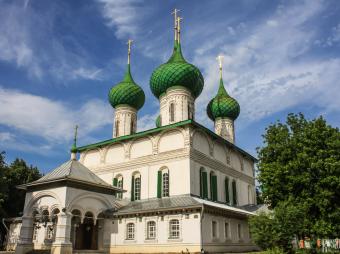
Church Ensemble at Tolchkov
- 72 Ulitsa Bolshaya Fedorovskaya
Also located in the former Tolkovskaya Sloboda is a church ensemble comprising the Our Lady of St Theodore Cathedral and the St Nicholas Pensky's Church. The cathedral was built between 1682 and 1687 and is famous for its massive green domes. From 1987 to 2010 the cathedral served as the eparchial cathedral of the Yaroslavl and Rostov Eparchy. Behind the cathedral is the St Nicholas's Church which is often called St Nicholas Pensky's Church to differentiate it from the other… Read more »
Ss Peter and Paul's Church
- 25 Ulitsa Zelentsovskaya, Petropavlovsky Park
Located in Petropavlovsky Park is Ss Peter and Paul's church which is unique among Yaroslavl's churches as it was constructed in the architectural style known as Petrine baroque. It was built between 1736 and 1742 and comprises an enormous blue two-storey building with a tall bell tower built on at one end. It looks especially pretty when viewed from across the pond located next to it. Read more »
Tolga

Svyato-Vvedensky Tolgsky Convent
- Tolga, Yaroslavl
- http://www.wix.com/tolgskymon/ru
In 1314 Bishop Propkhor (also known as Trifon) of Rostov founded the Tolgsky Monastery on the banks of the River Volga in the village of Tolga which has since been incorporated into Yaroslavl. It was founded on the site where an icon of the Virgin Mary and the infant Christ miraculously appeared. This icon is now known as the Our Lady of Tolga Icon and was said to be wonder-working. The monastery received many donations from people who claimed to have been healed by the icon,… Read more »


 History
History